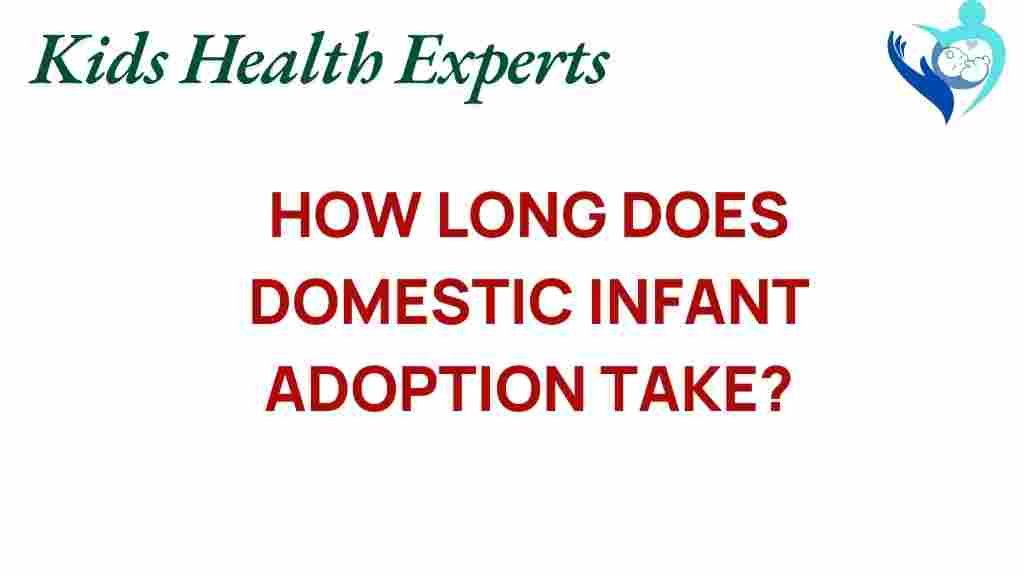Unraveling the Timeline: How Long Does Domestic Infant Adoption Take?
Domestic infant adoption is an emotional journey that many prospective parents embark on in hopes of expanding their families. Understanding the adoption process and the associated timeline can help ease the anxiety that often accompanies this significant life decision. In this article, we will explore the various stages of domestic infant adoption, the legal requirements, the waiting period, and the emotional aspects that parents should consider throughout their journey.
The Adoption Process: A Step-by-Step Guide
The adoption process can be complex and varies by state and agency. Here’s a breakdown of the typical timeline for domestic infant adoption:
1. Research and Preparation (1-3 Months)
Before diving into the adoption process, potential parents should spend time researching various adoption agencies, understanding their philosophies, and selecting one that aligns with their values. This phase might take anywhere from one to three months, depending on how much time you dedicate to it.
2. Application and Home Study (3-6 Months)
Once you’ve chosen an agency, you’ll need to complete an application, which typically includes:
- Personal information
- Background checks
- Financial evaluations
- References
After submitting your application, a home study will be conducted. This involves a social worker visiting your home to assess your readiness for adoption, which can take an additional three to six months.
3. Waiting Period (6-12 Months)
After being approved, you enter the waiting period. This is often one of the most challenging phases in the adoption process. During this time, you might be matched with a birth mother. The waiting period can last anywhere from six months to a year or longer, depending on factors such as:
- Your preferences regarding the child (age, race, health)
- The demand for infants in your area
- Your agency’s specific circumstances
4. Matching and Placement (1-3 Months)
Once a match is made, the agency will facilitate a meeting between you and the birth mother. This stage can last from one to three months. After the placement, you may take the infant home, but keep in mind that legal finalization is still pending.
5. Legal Requirements and Finalization (3-12 Months)
The finalization process involves several legal requirements, including:
- Filing legal paperwork
- Attending court hearings
This process can take anywhere from three months to a year to complete, depending on state laws and court schedules.
Understanding Legal Requirements
The legal requirements for domestic infant adoption can vary significantly by state. However, there are some common elements to consider:
- Home Study: A mandatory assessment of your home and lifestyle to ensure a safe environment for the child.
- Background Checks: Comprehensive checks to ensure the safety and well-being of the child.
- Consent from Birth Parents: Legal consent must be obtained from biological parents before adoption can proceed.
- Finalization Hearing: A court hearing to finalize the adoption where a judge will issue a final decree.
The Emotional Journey of Domestic Infant Adoption
The emotional journey involved in domestic infant adoption is profound and multifaceted. Here are key emotional aspects to consider:
1. Anticipation and Anxiety
The waiting period can be filled with anticipation and anxiety. Parents often feel a mix of excitement and worry as they await news of a match.
2. Attachment and Bonding
Once the child is placed with you, building a bond is essential. This period requires patience and love as both the child and parents adjust to their new roles.
Understanding your relationship with the birth family can be complex. Some families choose to maintain contact, while others prefer to keep it closed. It’s important to communicate openly with your partner about your feelings and expectations.
Family Planning Considerations
When considering domestic infant adoption, it’s crucial to think about how it fits into your overall family planning. Here are some factors to keep in mind:
- Financial Implications: Adoption can be expensive, so budgeting for costs is essential.
- Support Systems: Building a support network of family and friends can help you through the emotional ups and downs.
- Future Siblings: Consider how you envision your family structure and whether you plan to adopt more children in the future.
Here are some troubleshooting tips to help you navigate the domestic infant adoption process more smoothly:
- Stay Informed: Keep yourself updated on the laws and regulations in your state to avoid any surprises.
- Communicate Openly: Maintain open lines of communication with your adoption agency and partner for a smoother experience.
- Self-Care: Prioritize your mental and emotional health throughout the process. Engage in activities that bring you joy and peace.
- Be Flexible: Understand that the timeline can change, and be prepared to adapt to unforeseen circumstances.
Conclusion
The journey of domestic infant adoption is unique for every family, marked by its own challenges and joys. Knowing how long domestic infant adoption takes and understanding the adoption process can alleviate some of the stress associated with it. It’s essential to be patient during the waiting period, stay informed about legal requirements, and support each other emotionally as you navigate this life-changing decision.
If you are considering domestic infant adoption, resources are available to guide you through the timeline and process. Whether it’s connecting with an adoption agency, joining support groups, or reading adoption stories, there is a wealth of information to aid you on your journey. For more information on adoption resources, visit Adoption.org.
Remember, every step taken brings you closer to welcoming a new member into your family. Embrace the journey, and know that you are not alone.
For more insights on family planning and adoption, check out our detailed guide here.
This article is in the category Care and created by KidsHealthExperts Team
